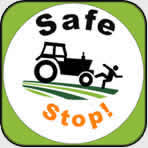Because of the wide variety of activities involving transport in agriculture, it is easier to identify problems and take action if you break your transport activities into areas:
Safe stop

- Engage handbrake
- Controls in neutral
- Switch off engine (or turn off power)
- Remove key (or lock-off the power supply)

Follow Safe Stop:
- before leaving the driver's seat/operating position;
- when anyone else approaches;
- before anyone carries out maintenance, adjustments or deals with a blockage.
The images above have been developed by the Farms Safety Partnership. For more details of the Partnership's Safe Stop[1] campaign visit their website.
Safe vehicle
Check that vehicles, machines and handling equipment are:
- suitable for the work and capable of safely performing the jobs to be done, with reversing aids such as mirrors;
- inspected daily and faults repaired promptly;
- properly maintained, paying particular attention to braking systems.
Check that your vehicles, or any machines with workers riding or working on them, are fitted with roll-over protective structures (ROPS) and seatbelts if there is a risk of overturning.
Check that:
- drivers of lift trucks and loaders are protected from falling objects;
- loads are stable and secure;
- trailers have adequate brakes designed for the maximum loads and speeds at which they will operate;
- keys are kept secure when vehicles are not in use.
Safe driver
Check that drivers:
- are medically fit to drive;
- are properly trained and unauthorised people are not allowed to drive;
- know how to safely enter and exit the vehicle.
Never allow passengers to ride on or in vehicle cabs unless they are sitting on a passenger seat in a safe position and cannot impede the driver, accidentally contact the machine controls, or obscure the driver's vision. No-one should mount or dismount a moving vehicle.
Safe site
Check that:
- vehicles and pedestrians are separated where possible;
- visiting drivers are aware of your rules, including parking areas, one-way systems etc;
- vehicle routes reduce the need to reverse, eg by adding turning circles, or using one-way systems;
- traffic routes are properly maintained and adequately lit;
- warning and speed limit signs are clear and consistent with the Highway Code.
- locate silos and stores in a safe place away from OHPLs to reduce risks during feed deliveries
Never approach or walk behind or beside a reversing vehicle. If you must approach, attract the driver's attention first when it is safe to do so and get them to stop especially if you need to speak to the driver or mount the machine.
- Audible alarms can be fitted to vehicles to warn people when they are reversing
- Never attempt to squeeze between a moving vehicle and a doorway or fixed object
- If possible have separate doorways in buildings for vehicles and pedestrians
- Wear high visibility clothing to help others see you